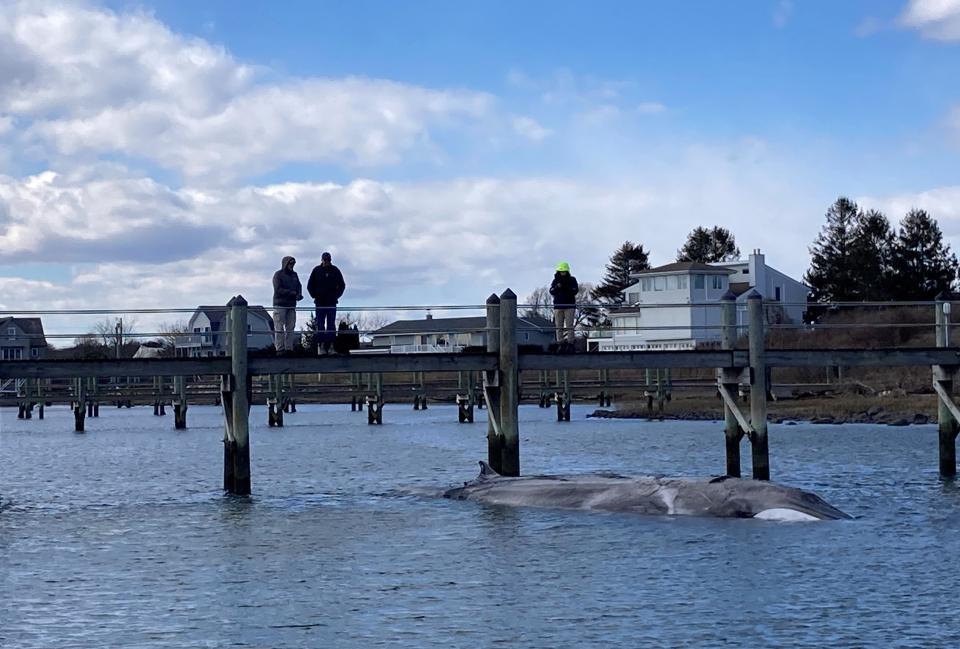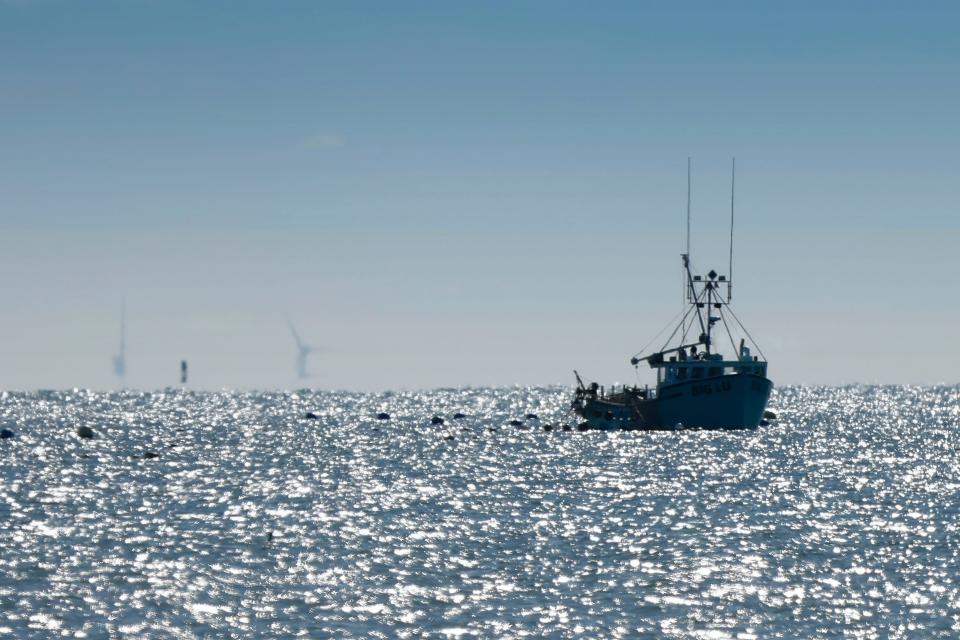Scientists: No link between whale deaths and offshore wind construction. Here's why.
SOUTH KINGSTOWN – After a whale was stranded, and later died, in a South Kingstown salt pond this week, there was quickly speculation on social media that construction of offshore wind farms in ocean waters near Rhode Island disoriented the animal, driving it into the coastal shallows.
Similar allegations have been made repeatedly in connection to other recent whale strandings and deaths all along the Northeast coast.
But scientists say there is no evidence that offshore wind construction is causing whale injuries or deaths.
“There’s absolutely zero evidence of any effect from what’s gone on so far at the wind farms and any serious impacts on whales,” said University of Rhode Island marine mammal biologist Robert Kenney.
Kenney, an emeritus marine research scientist at the Graduate School of Oceanography who has studied whales, dolphins and other marine vertebrates for 35 years, describes the conjectures linking offshore wind to whale mortality as misinformation.
Fed up with hearing so much on the subject over the past year as offshore wind construction has picked up off Massachusetts and Rhode Island, he wrote an article recently in Rhode Island Naturalist debunking the claims.
The title: “Science says that wind farms are not killing whales.”

Whales would swim away from loud sounds
Construction of offshore wind farms can be very loud. The piles that anchor wind turbines to the ocean floor must be driven deep into the sediments. To do that, they are essentially hammered into place. The sound from each strike can travel far underwater and has been detected by microphones at very low levels up to 60 miles away.
But developers are required to employ marine mammal monitors to look out for whales near the construction zones. They also use acoustic sensors in the water to detect whales. If the animals stray too close, construction activities are suspended.
Developers employ other methods to reduce impacts on marine mammals, such as bubble curtains that dampen the sound of pile driving. They also ramp up the sound of pile driving to give animals time to move away from any disturbance.
More: Multiple endangered whales found dead on nation's coasts, alarming conservation groups
And swimming away is just what whales would do were they to encounter sounds that are too loud, said Kenney.
He said the worst-case scenario would be temporary hearing loss if a whale were in the direct vicinity of pile driving, but he emphasized that such a situation would be unlikely considering the precautions that are being taken.
“We understand the physics of underwater sound really well,” he said. “We know what’s going on. You can measure the source level of a sound. You can calculate the distance it travels underwater. The sound sources that are out there, they are not loud enough to kill marine mammals.”

Pile driving hasn't occurred in several months
University of Rhode Island acoustician James Miller agreed with Kenney about the speculation blaming offshore wind for whale deaths.
“There's really no scientific basis for any of the stuff we’ve been hearing over the past year or two,” he said.
Miller, chair of URI’s ocean engineering department, has studied sounds from the construction of every offshore wind farm in the United States, starting with the nation’s first, the Block Island Wind Farm, the five-turbine test project completed in 2016.
He followed that up with work on the two-turbine Coastal Virginia Offshore Wind project and has continued with studies of Vineyard Wind and the South Fork Wind Farm, the two projects that have been in construction off Massachusetts and Rhode Island since last year.
Miller said that whales are tough animals that aren’t bothered by most man-made sounds in the ocean. The only proven exception is explosive dredging using dynamite, which was employed in Canada many years ago. There’s also inconclusive evidence tying military sonar to beaked whale strandings, according to Discovery of Sound in the Sea, a website Miller and other experts in ocean acoustics maintain.
Pile driving is very loud, but Miller said that because the waters are relatively shallow where the South Fork and Vineyard projects are being built, the sound is absorbed by the ocean floor and doesn’t travel as far as it would in deeper waters.
And the mitigation measures do help. His studies of bubble curtains found that they shave off about 10 decibels of noise from pile driving.
The species of most concern during offshore wind construction is the North Atlantic right whale, which is critically endangered. Developers have worked with advocates, government agencies and scientists to schedule pile driving to avoid the winter months when the whales are migrating through Southern New England.
It has been several months since any pile driving was done in connection with the South Fork or Vineyard projects.
As to continuing sound from wind farms in operation, like the Block Island project, Miller said it is so low that at about 160 feet away it can’t be detected above background noise.
In a statement, Ørsted, the company behind both the Block Island and South Fork projects, said none of its vessels have experienced whale strikes during survey activities or construction.
"The offshore wind industry is subject to the most stringent level of protections for marine mammals and protected species," the company said.
Climate change may be tied to whale deaths
There has been a spike in the deaths of certain marine mammal species in recent years.
The National Oceanic and Atmospheric Administration declared “unusual mortality events” for humpback whales in 2016, North Atlantic right whales in 2017, and minke whales also in 2017. None have been connected to offshore wind construction.
“There are no known links between large whale deaths and ongoing offshore wind activities,” NOAA has said.
The minke whale event has been tied to disease and ship strikes, and the right whale event to ship strikes and entanglement, including from fishing gear. While no cause has been determined for the humpback whale event, about half of the carcasses that have been studied showed signs of ship strikes or entanglement, said Kenney.
While there are still unanswered questions about the humpback deaths, he said one possible explanation could be that prey have shifted as oceans have warmed. Whales in turn have followed them into areas with higher ship traffic.
That’s what appears to have happened with right whales, which switched their summer feeding grounds from the Gulf of Maine to the Gulf of St. Lawrence.
“The apparent result was 17 dead whales in 2017 and 10 in 2019, with vessel strikes and entanglement the only causes shown by necropsy results,” Kenney wrote in his Rhode Island Naturalist article.
Fin whale was likely sick, expert said
The whale that was stranded in Potter Pond in South Kingstown Thursday, a juvenile fin, was euthanized that night. Officials with the Mystic Aquarium said the animal looked emaciated and was probably so weak that it floated in on the tide.
A necropsy was conducted on Friday and the findings will be used to help determine the cause of death for the fin whale.
Kenney said it’s likely the animal was sick.
It’s not the first whale to be stranded and it won’t be the last. A second whale, a pilot whale, also washed up in South Kingstown, on Moonstone Beach, on Thursday, though experts say this whale likely died in the ocean and was washed in during the recent storm. Miller’s website makes clear that there’s a long history of whale deaths all around the world.
“The fact is that observations as far back as Aristotle and illustrations from the Middle Ages show us that marine mammals have been stranding long before people created underwater sounds,” the site says.
This article originally appeared on The Providence Journal: After whale dies, speculation up but experts say no link to offshore wind

